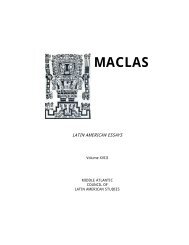latin american essays maclas
latin american essays maclas
latin american essays maclas
Create successful ePaper yourself
Turn your PDF publications into a flip-book with our unique Google optimized e-Paper software.
U.S. foreign policy) are permissive, the response could be a repressive military<br />
government.<br />
Conclusion. Almost all Latin American countries have made the<br />
transition to democratic regimes in the last 25 years, while they have also moved<br />
(under strong international pressure) toward neoliberal political economies<br />
featuring reduced state control and increasingly free trade. The quality of<br />
democratic performance has generally been poor, and popular disillusionment<br />
has often focused on the poor results of neoliberal economics (Peeler 2004).<br />
Notwithstanding disillusionment, in Central America there are currently no<br />
organizational vehicles to transform it into instability. This outcome is very much<br />
in contrast to mounting mass resistance by the radical left in the Andean<br />
countries of Bolivia and Ecuador, and to the rise to power of leftists in Venezuela,<br />
Brazil, Argentina, Bolivia, Chile and Uruguay (Robinson 2004; Panizza 2005).<br />
In Central America, unlike South America, the United States still sets very<br />
explicit boundaries to acceptable political behavior. While the U.S. did not<br />
achieve military victory in the conflicts of the 1980s and did not annihilate leftist<br />
movements, it has both blocked them from coming to power by electoral means<br />
(in Nicaragua and El Salvador) and successfully pressured them to moderate<br />
their programs in the hope of gaining U.S. acceptance. Neocolonialism is a<br />
concrete reality in Central America.<br />
Behind the apparent similarity in the positions of the FSLN and the FMLN<br />
since the peace settlements, there are significant differences. The FSLN has<br />
become completely integrated into a corrupt post-revolutionary system, which<br />
was—until the elections of 2006—jointly controlled with their arch–rivals of the<br />
PLC (under the close supervision of the U.S. Embassy). The FMLN, in contrast,<br />
continues to be a true opposition party with a serious commitment to a program<br />
of significant social change. Both parties are weaker among the peasantry than<br />
one might expect, while their right wing opponents are more successful with<br />
traditional clientelism and cultural conservatism. The FMLN is fundamentally a<br />
party of the urban middle class (considerably more numerous than that of<br />
Nicaragua), while the FSLN is strong among the urban working class and poor.<br />
The situation in Guatemala bears little apparent similarity with the two<br />
neighbouring countries. The former guerrillas of the URNG were much less<br />
successful militarily than the other two insurgencies, and have failed to take hold<br />
as a major electoral force. A possible explanation is that the forces of the Right<br />
are so strong in Guatemala that they have not needed to form a stable ruling<br />
party, or even to dominate electoral politics. They have the military, and, if<br />
necessary, the U.S.<br />
The left is no threat in Nicaragua because it has ceased to be seriously<br />
leftist, in El Salvador because it has failed to build a sufficient mass base among<br />
the poor, and in Guatemala because it was a spent guerrilla force, and could not<br />
cross the threshold of being a serious electoral party. Ironically, three countries<br />
27




